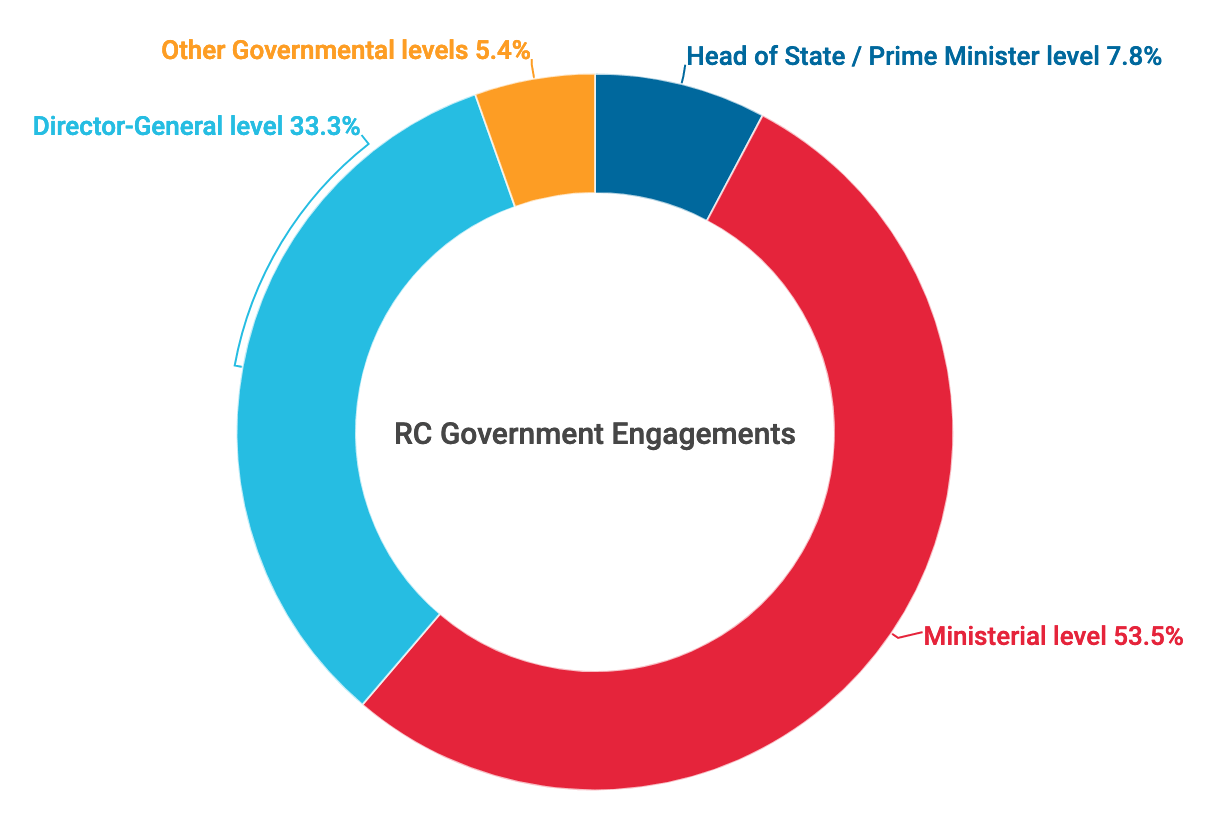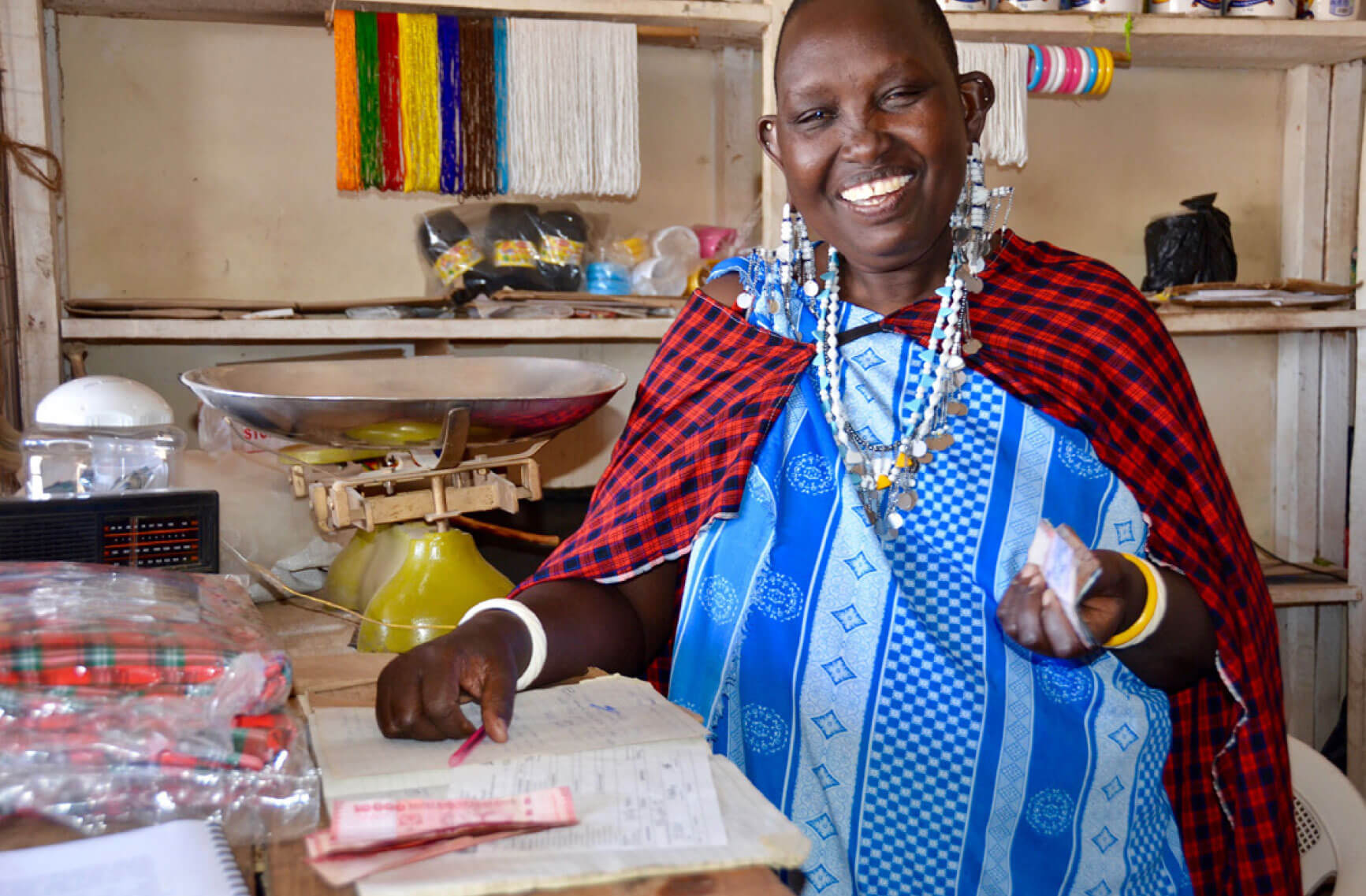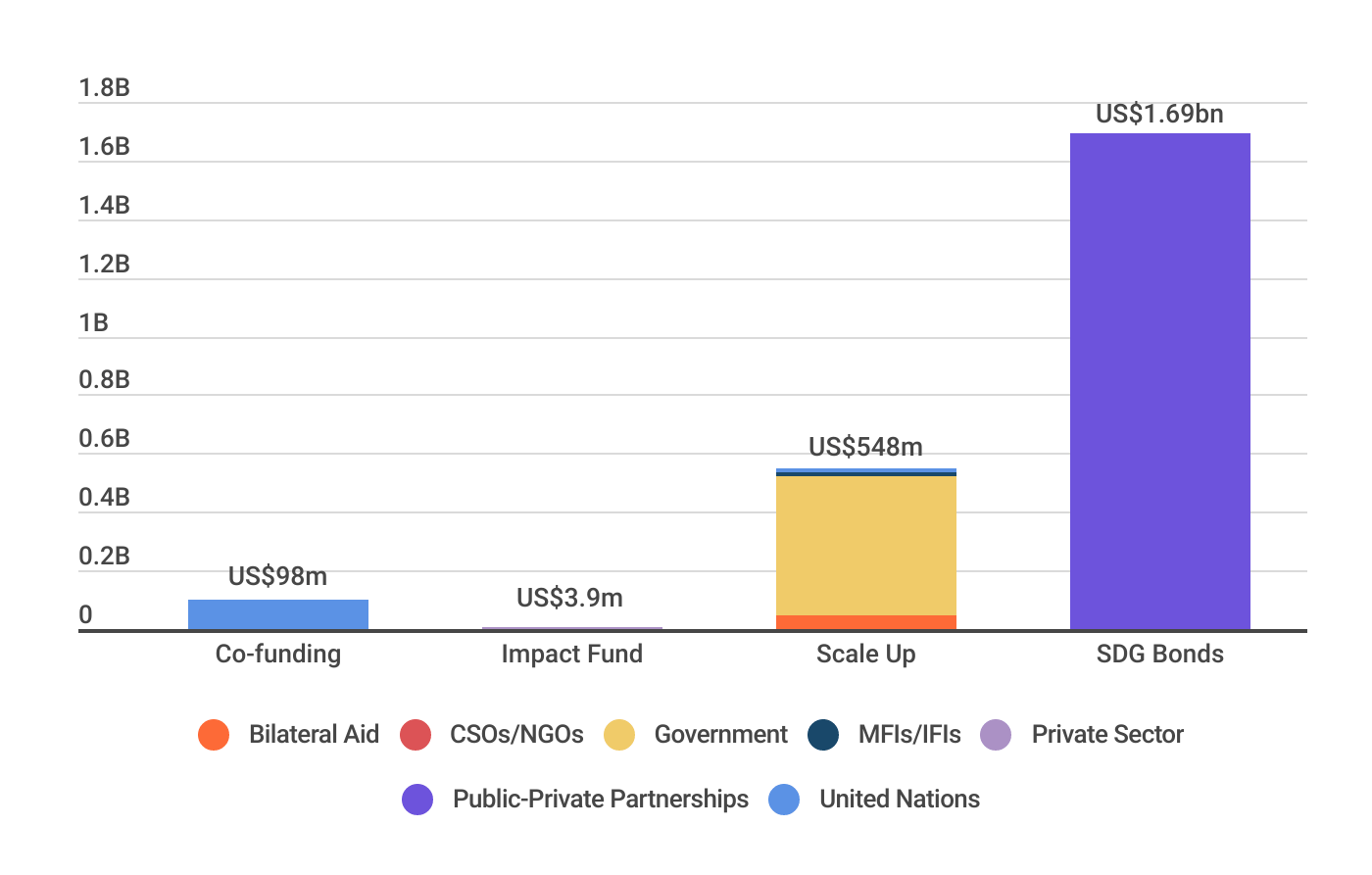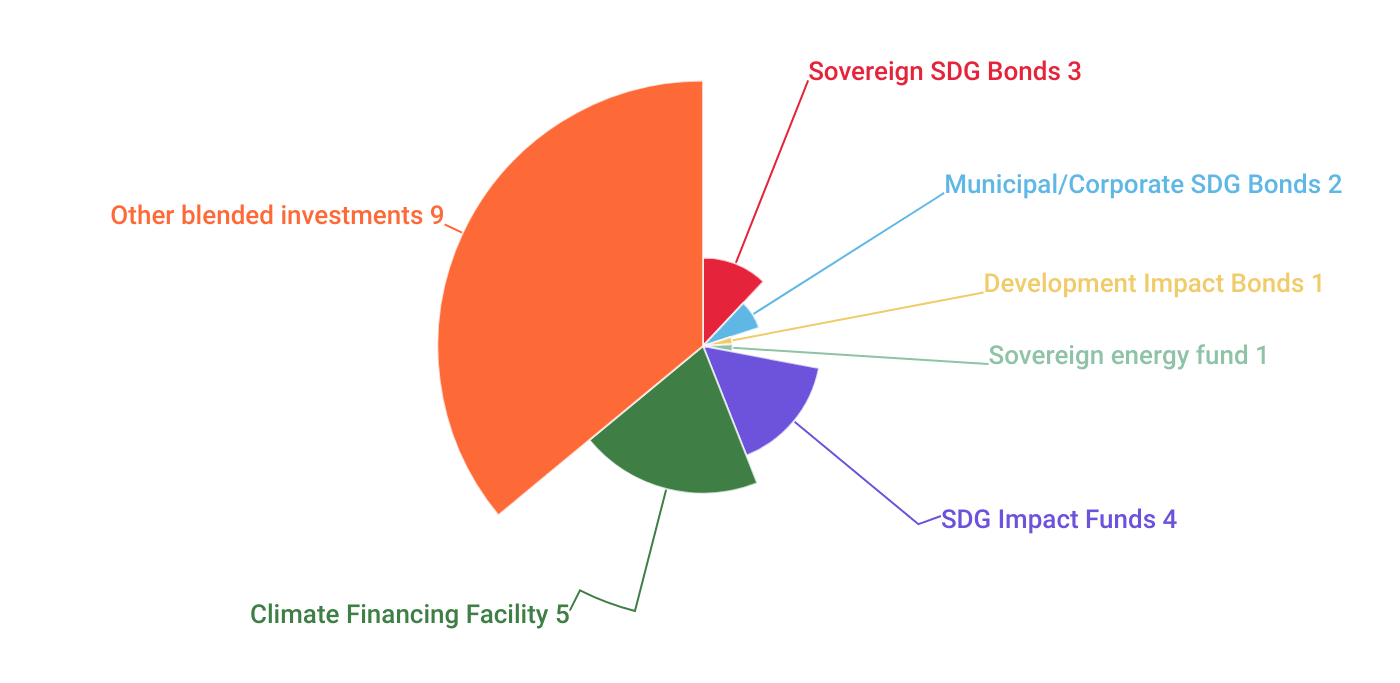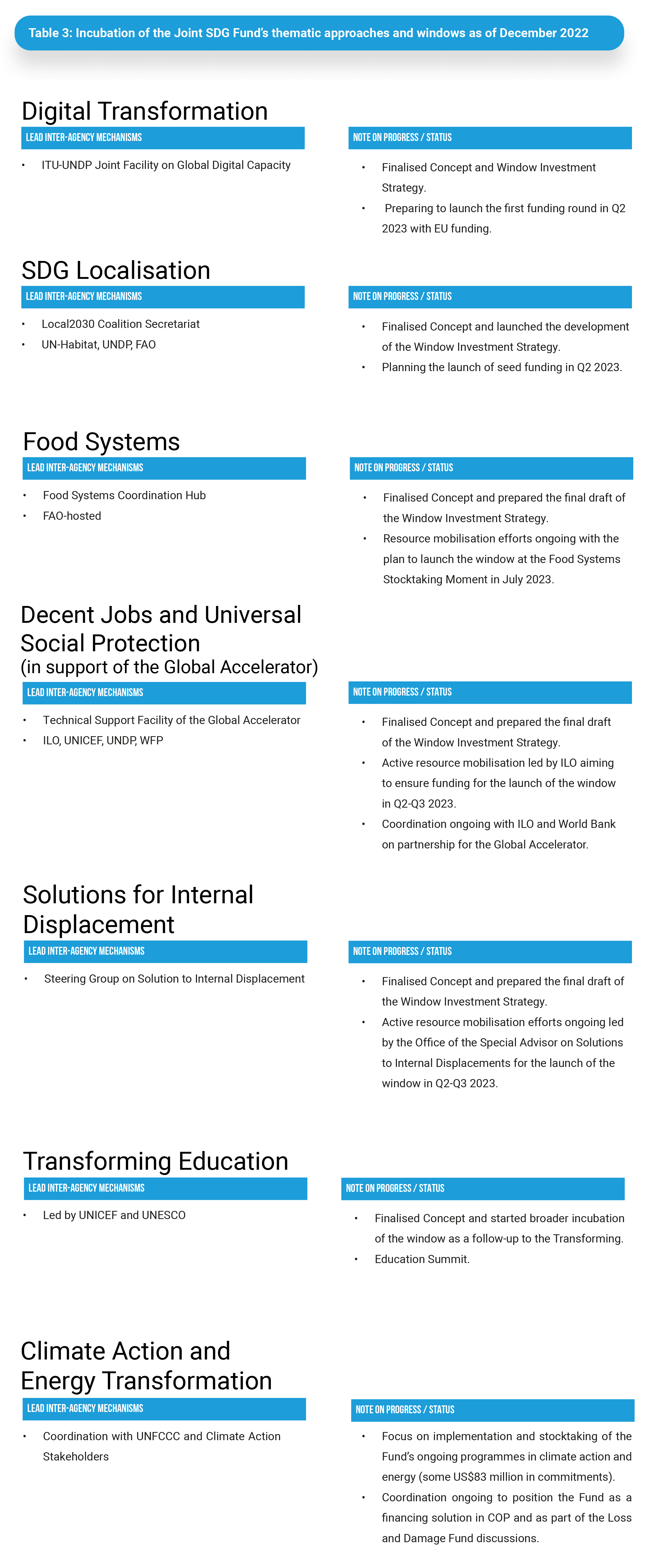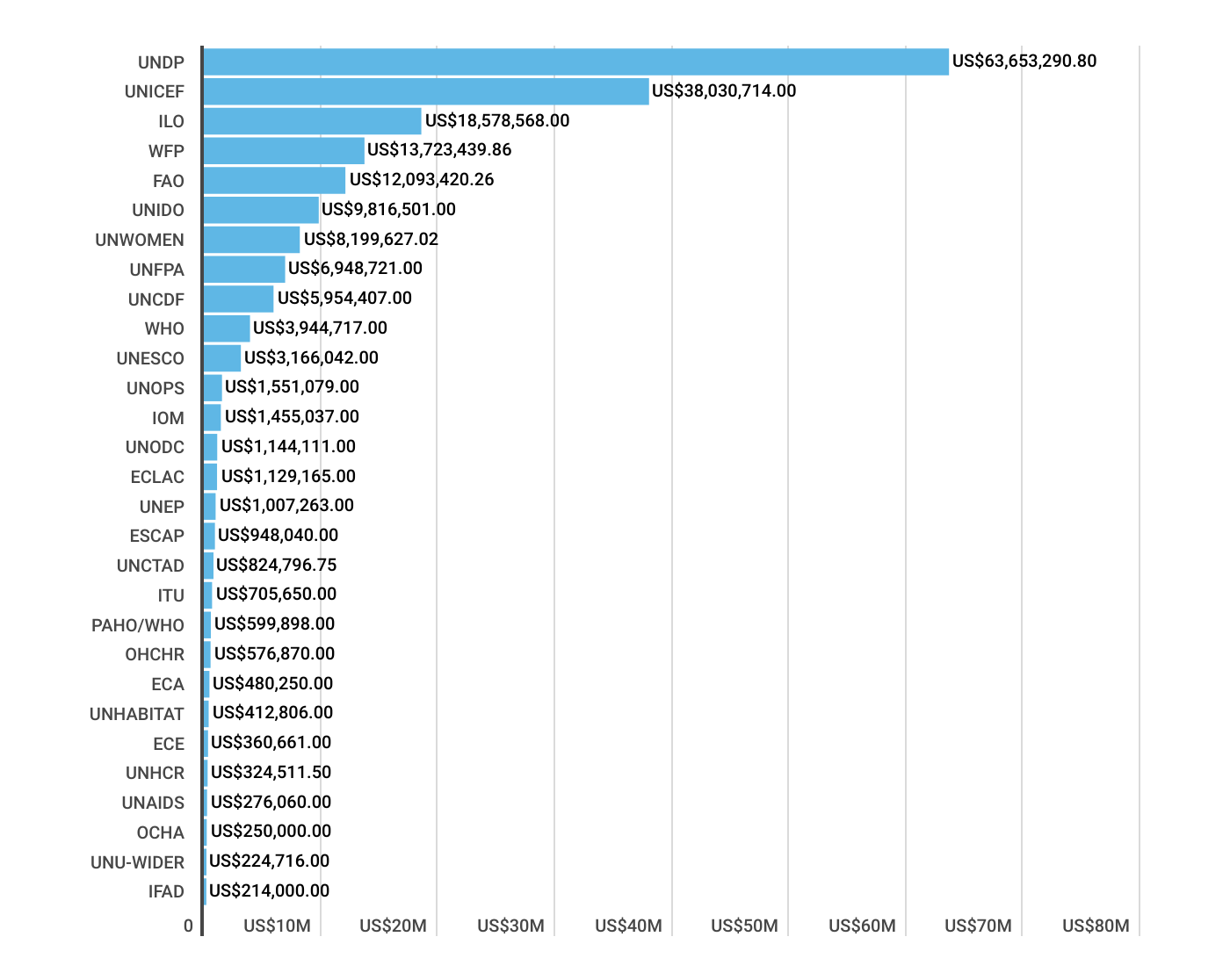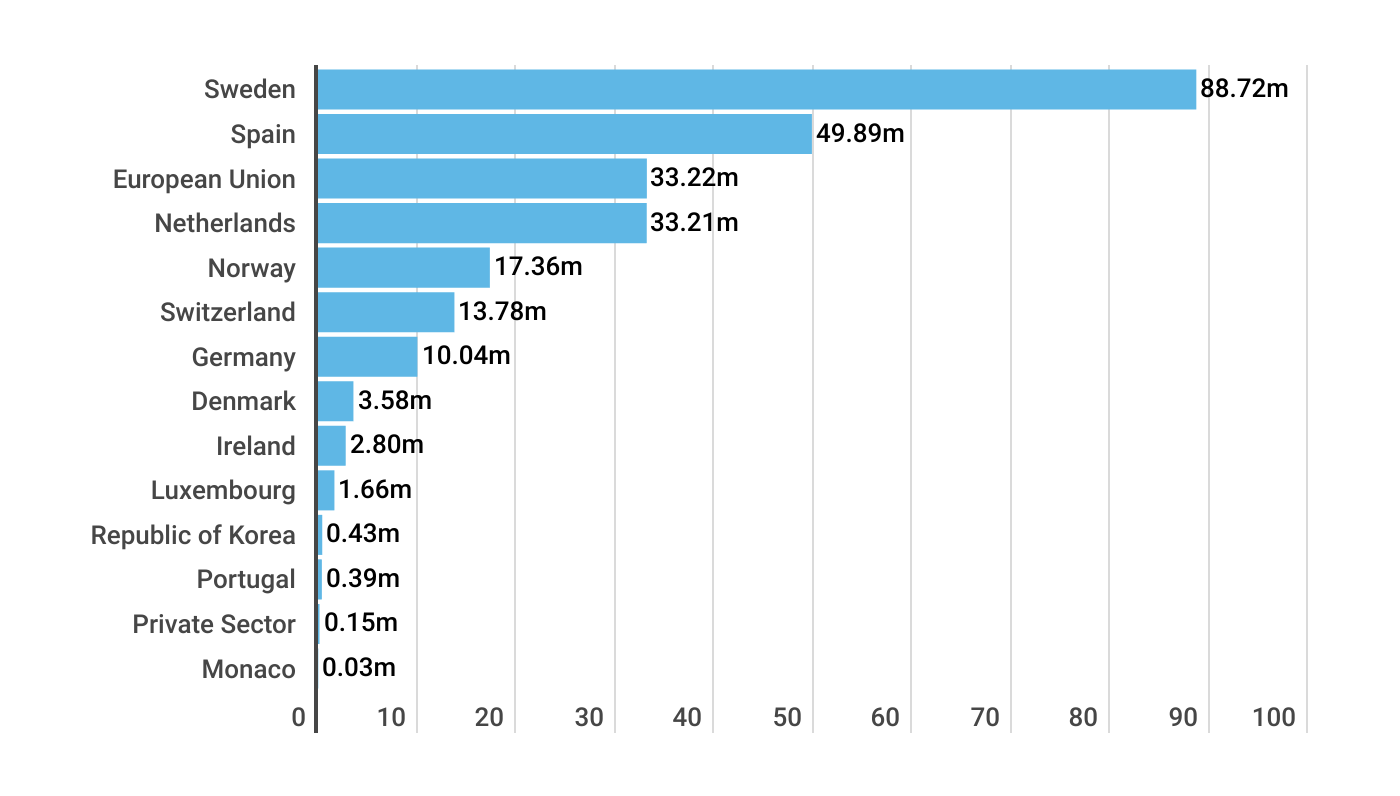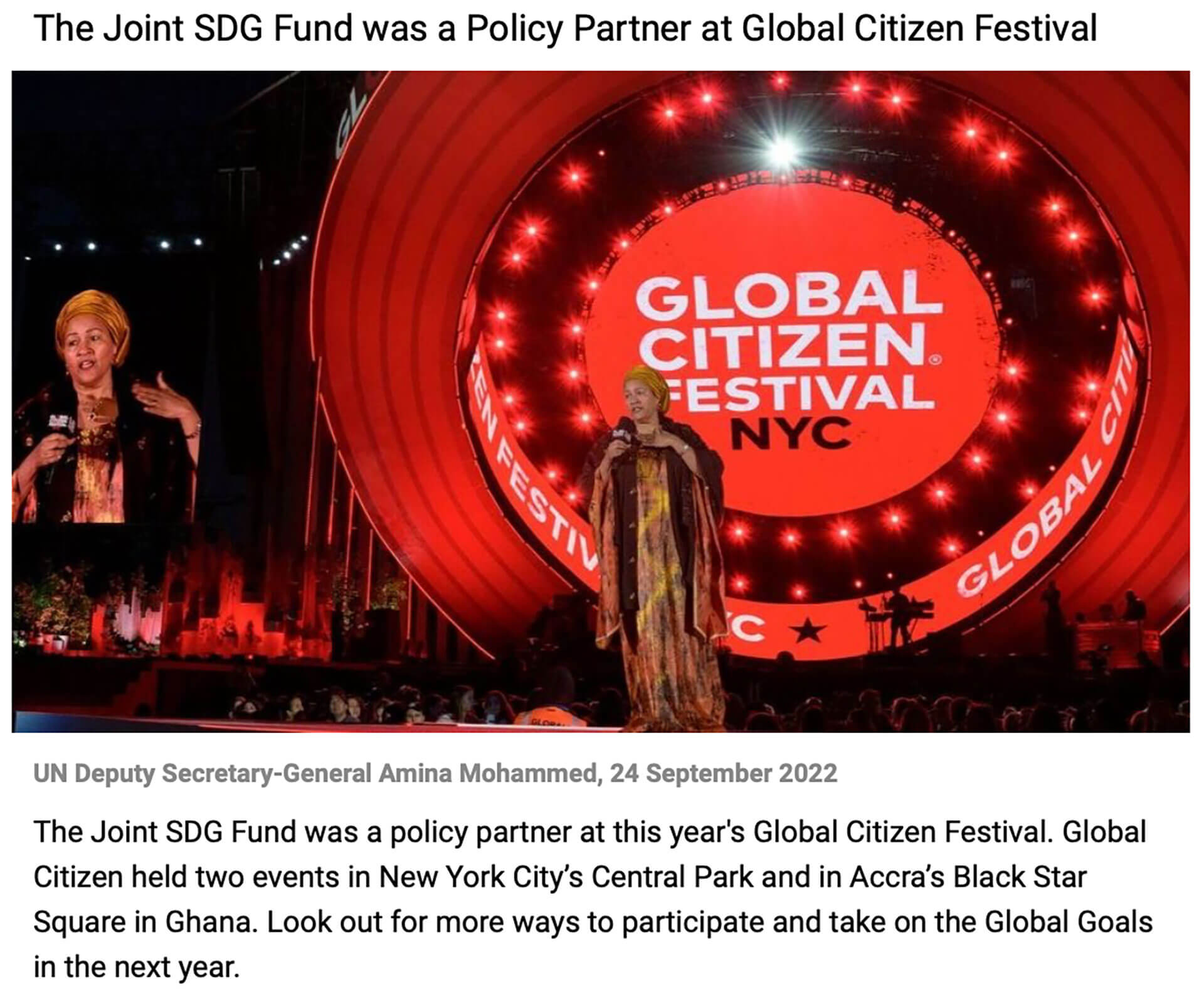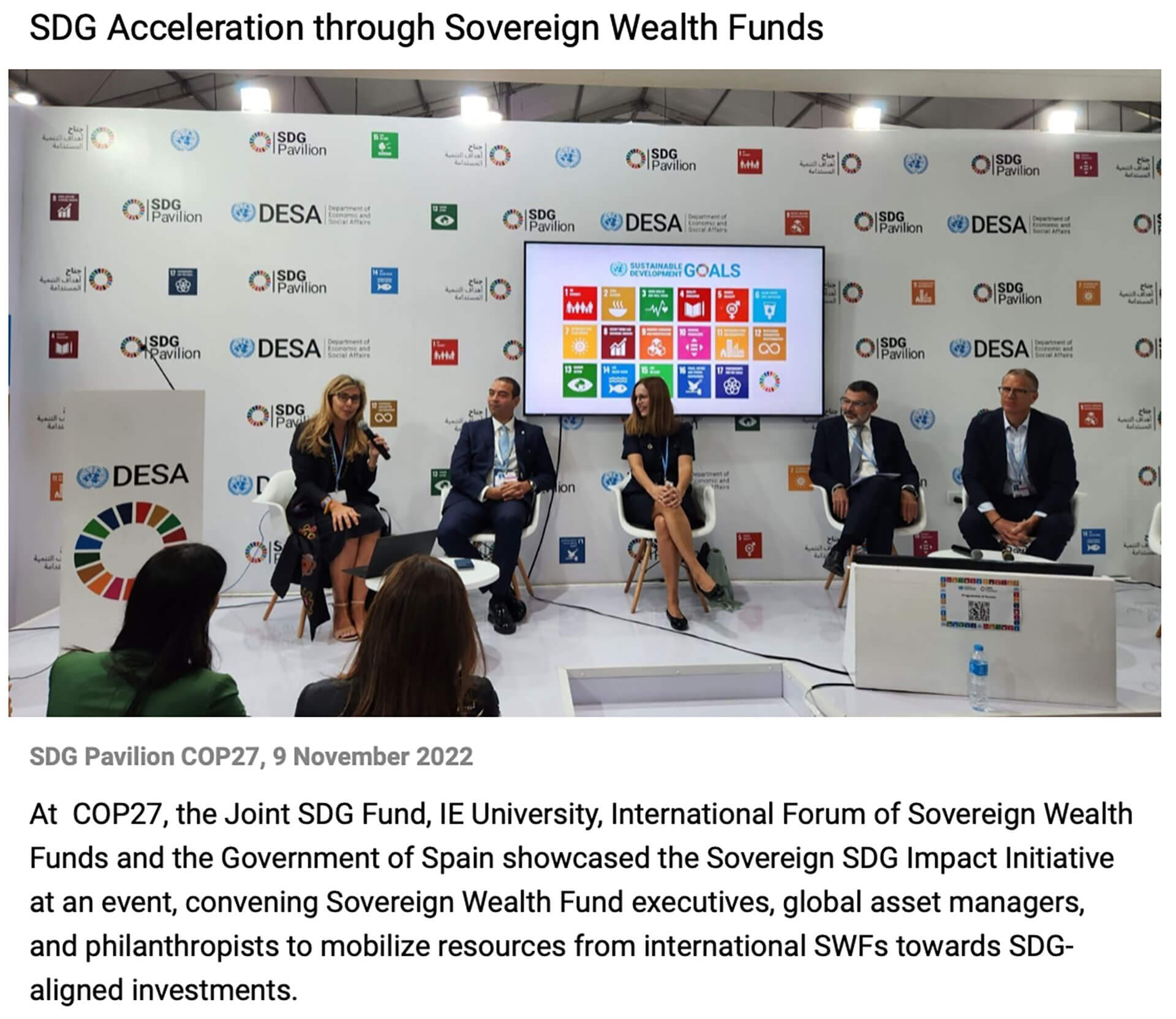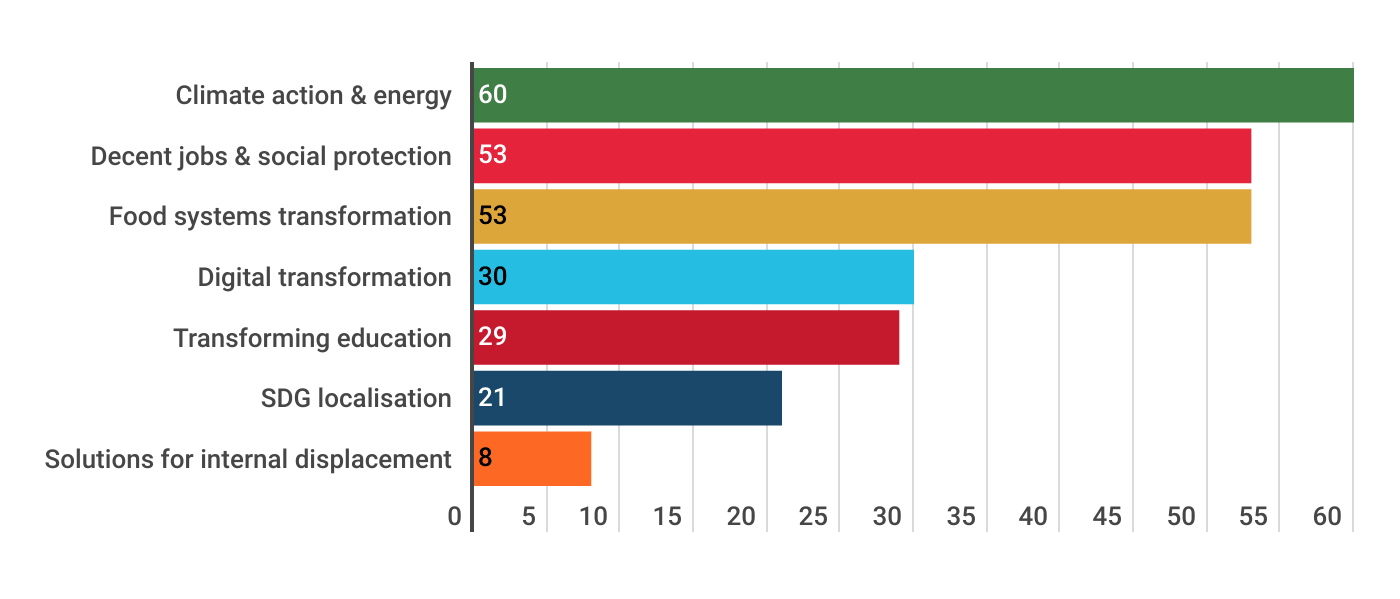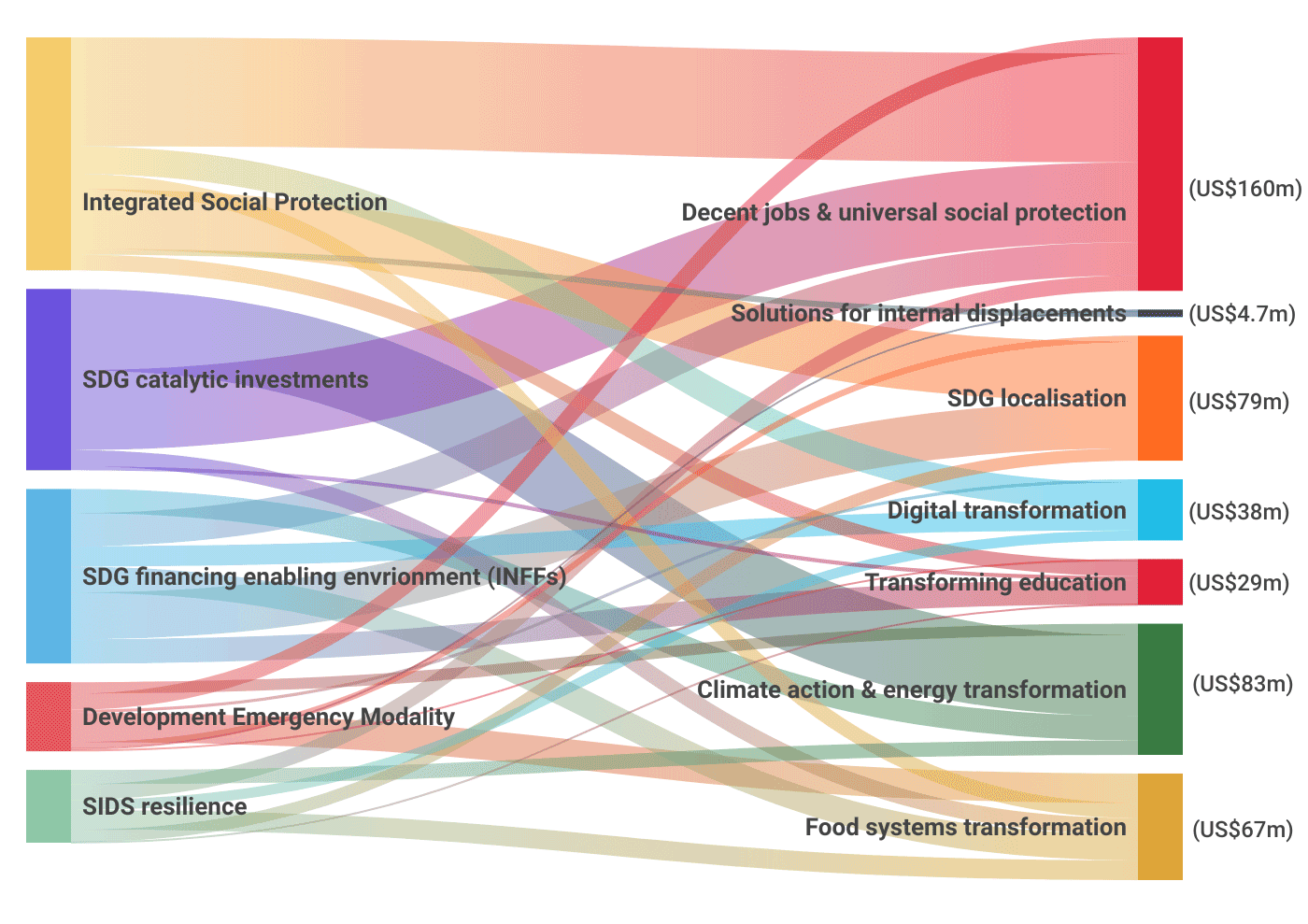
2022 Annual Report
2022 Highlights

accessed new or extended social services based on the Fund’s support to joint programmes.

including non-resident UN entities and the Development Coordination Office are jointly working together to accelerate the SDGs.

are operating joint programmes under the Resident Coordinators’ leadership with the Joint SDG Fund’s support.

piloted in relation to the SDG financing strategies to finance the national sustainable development priorities.

catalysed for SDGs in leaving no one behind and SDG financing strategies and investments.

were approved for SDG acceleration and financing through the 233 Joint Programmes.
RCs Recognised
that the Joint SDG Fund contributed to focusing on common results based on United Nations Sustainable Development Cooperation Frameworks.
Joint Programmes
have gender markers that are at or above level 2 with significant or principled activities in gender equality.
Funds Allocated
were for vulnerable country groups (i.e. LDCs, LLDCs, SIDS) to enhance their resilience and accelerate their SDG progress.

“Commit to fully support the UN development system to deliver better in support of Member State efforts to drive SDG transformation for inclusivity and sustainability, capitalising the UN Joint SDG Fund by at least US$1 billion by September 2024.”
António Guterres, United Nations Secretary-General
‘Progress towards the Sustainable Development Goals: Report of the Secretary-General (2023)’
Introduction
Global Context and SDG Impact
Compounding challenges impacting the SDGs

“Commit to fully support the UN development system to deliver better in support of Member State efforts to drive SDG transformation for inclusivity and sustainability, capitalising the UN Joint SDG Fund by at least US$1 billion by September 2024.”
António Guterres, United Nations Secretary-General
‘Progress towards the Sustainable Development Goals: Report of the Secretary-General (2023)’
Introduction
Global Context and SDG Impact
Compounding challenges impacting the SDGs
Galvanising the Collective Power of the United Nations for the SDGs
The United Nations Joint SDG Fund endeavours to turbocharge the 2030 Agenda by addressing the fragmentation of the UN’s global response. The Fund assists countries in regaining lost ground by identifying and financing catalytic actions to accelerate sustainable development. The Fund leverages collective capacities, networks, and resources of the UN development system, brought together under the leadership of Resident Coordinators (RCs) to support Governments and local communities in priority areas based on their national needs as outlined in UN Sustainable Development Cooperation Frameworks (CFs).
In 2022, a System-Wide Evaluation conducted by the newly established UN system-wide evaluation office focused on assessing the Fund’s strategic value and providing forward-looking recommendations. The evaluation concluded that the Fund was effectively achieving its strategic purpose in financing UN catalytic actions to accelerate the SDGs: “The joint programmes supported by the Fund are living up to the Fund’s strategic intentions considering the complexity of its mission…[and] has supported new types of joint programmes leveraging the new generation of RCs and UNCTs with new partnerships within UN Development System (UNDS).” The System-Wide Evaluation of the UNDS response to COVID-19 also assessed the Fund’s actions in light of the UNDS response. It concluded that pooled funds, including the Joint SDG Fund, have “facilitated new partnerships among UNCT entities which may have lasting impacts on collaboration” and have been influential in leveraging much larger investments by bilateral development partners and development banks. In 2023, the Fund will be actively implementing the evaluation recommendations to strengthen its governance, operations, and capabilities, ensuring its valuable contribution towards promoting coordinated UN efforts to hasten the achievement of the SDGs.
To date, the Joint SDG Fund has made US$258 million in financial commitments to 119 UN country teams and multi-country offices, with 30 UN entity partners. The Fund works in the areas of inte-grated social protection, SDG financing and investments, boosting resilience in Small Island Developing States (SIDS), and supporting the UN collective response to the global cost-of-living crisis (see Table 1). The primary outcomes and progress of these portfolios are described comprehensively in the subsequent sections, pre-senting our impact and highlighting our lessons learned.
Across the portfolio, the Fund has made significant contributions to the SDGs (see Table 2). Since its launch, the Fund’s portfolio has benefited at least 188 million people with enhanced social services including in areas of social protection, expanding vaccine coverage, awarding scholarships, and delivering other essential services. The Fund contributed to achieving tangible progress under Goal 17, where it has mobilised over US$2.3 billion in additional resources through its promotion of innovative financial instruments as well as its policy demonstration and co-funding to joint programmes. Every US$1 contributed by the Fund mobalised at least US$9 of additional resources across the public and private sectors to support the SDGs. Additionally, the Fund has made significant advancements toward achieving Goal 5 by supporting over 38 countries to establish monitoring systems to track public allocations for gender equality and mainstreaming gender equality results throughout its portfolio.
Serving as the programmatic catalyst in empowering the RC system to enhance UN coherence, the Fund promotes integrated programming and reduces duplications and operational inefficiencies at the country level. The Fund is seen, together with the Peacebuilding Fund and the Central Emergency Response Fund, as a critical pillar of the UN system, “to improve overall effectiveness on the ground and contribute to a longer-term effort to introduce more
flexible pooled funding mechanisms” and is included as part of the Funding Compact to the UNDS reform. It is recognised for driving innovative joint action under RC leadership and bringing together diverse partners for SDG integrated policies and financing.
In particular, the Fund has consistently contributed to enhancing UNCT alignment with common results based on
the Cooperation Frameworks and facilitated coordinated strategic engagement with Government partners. Over 60 per cent of the RCs indicated that they strategically collaborated with government partners at the Heads of State, Prime Ministers, or ministerial levels to ensure an integrated policy response leveraging the joint programmes (see Figure 1). For instance, the RC in Somalia highlighted how the Fund’s support was instrumental in bringing both the UN entities as well as,different line ministries and the Office of the Prime Minister together in devising a common policy approach for sustainable energy and alternative livelihoods.
The Fund has also helped demonstrate the efficiency of UN joint actions in avoiding duplicated efforts by UN entities and reducing transaction costs for programming. For instance, the RCs in Bhutan, Fiji, and other UNCTs highlighted the Fund’s support as critical in enhancing UNCT coordination and demonstrating the value-add of joint actions in terms of using common operational procedures and tools such as sharing long-term agreements, conducting joint assessments, and engaging in joint resource mobilisation. The RCs in the SIDS also emphasised the Fund’s central role in enhancing coordination between UN resident and non-resident entities in joint programming. These reports on the Fund’s positive contributions to UN coordination illustrate the Fund’s critical role in empowering the RC system and incentivising collective action by promoting of UN common frameworks and tools. Further details on the Fund’s contributions to UN coherence and the RC system are described in the ‘Tracing steps towards progress’ section.
THE OPERATIONAL STEERING COMMITTEE
Achim Steiner
UNDP Administrator
“The UN Joint SDG Fund has become an important instrument for UN Country Teams and Resident Coordinators to accelerate the implementation of the 2030 Agenda. On behalf of UNDP, I would like to extend my sincere gratitude to current and past donors for their invaluable support to the Fund.”
‘UN Joint SDG Fund Development Partners Retreat (2022)’

Natalia Kanem
UNFPA Executive Director
“UNFPA is a proud partner of the UN Joint SDG Fund. Through flexible financing that aligns with local needs and priorities, the Fund is making a difference on the ground where it counts.”
‘UN Joint SDG Fund Development Partners Retreat (2022)’

Catherine Russell
UNICEF Executive Director
“The UN Joint SDG Fund plays a critical role in mobilising the resources we need to achieve the 2030 goals. UNICEF is grateful for the Fund’s contributions in support of our work to make the SDGs a reality for children and women around the world.”
‘UN Joint SDG Fund 2022 Annual Report (2023)’

Gilbert F. Houngbo
ILO Director-General
“The UN Joint SDG Fund represents a powerful instrument for harnessing the collective strengths and resources of the UN system to drive integrated policy support and accelerate progress on the SDGs.”
‘UN Joint SDG Fund 2022 Annual Report (2023)’

Cindy H. McCain
WFP Executive Director
“Delivering development and humanitarian results and building resilient food systems is central to the mission of the United Nations, and the Joint SDG Fund is an important tool for accomplishing this. With a global food crisis at hand, our collective work toward achieving zero hunger is more important than ever. Now is the time for increased and sustained investment to meet our collective target.”
‘UN Joint SDG Fund 2022 Annual Report (2023)’

List of 31 United Nations Organisations
of the Joint SDG Fund
ECA
ECE
ECLAC
ESCAP
FAO
IFAD
ILO
IOM
ITU
OCHA
OHCHR
PAHO/WHO
UNAIDS
UNCDF
UNCTAD
UNDP
UNEP
UNESCO
UNFPA
UNHabitat
UNHCR
UNICEF
UNIDO
UNODC
UNODC
UNOPS
UNU-WIDER
UNV
UNWomen
WFP
Our Impact
Outcome 1. Accelerating SDG Achievement Through Integrated Multi-Sectoral Policies
In 2022, the Joint SDG Fund focused on finalising and ensuring the sustainability and scale-up of the Fund’s inaugural set of 35 joint programmes in Integrated Social Protection and Leaving No One Behind (LNOB). The Fund also launched new major programmatic initiatives in building resilience in the SIDS and supporting the UN’s collective response against the global cost-of-living crisis brought on by the war in Ukraine.
The Joint SDG Fund benefited at least 147 million people, especially those who were initially left behind, to access new or extended social protection services. The Fund also leveraged at least US$411 million in additional resources to sustain and expand national social protection systems.
The Fund launched a dedicated portfolio of 25 joint programmes (including 7 working on SDG financing) covering 42 SIDS countries and territories aligned with their national priorities and contributions to the SAMOA Pathway.
The Fund swiftly responded to the global cost-of-living crisis under the guidance of the UN Global Crisis Response Group by supporting preparatory actions to 85 UN country teams.
Trailblasing SDG Action Through Integrated Social Protection
In 2022, the Fund successfully completed its initial set of 35 joint programmes focusing on integrated social protection and LNOB implemented in partnership with 16 UN organisations in 39 countries. These joint programmes, launched in 2019, were designed to address a range of policy, institutional, and financial bottlenecks hindering the achievement of the SDGs, and to strengthen the effectiveness of national social protection systems for the most vulnerable. The portfolio operated with a total budget of US$100.6 million, among which US$31.5 million was co-funded by the UN entities.
Through this joint UN effort, the Fund supported Governments to expand access to new or improved social protection services to 147 million people (50 per cent women and girls), mainly targeting those left behind and impacted by the compounding crises. Critical lessons have been identified from the portfolio’s best practices and its decentralised evaluations. These include the added value of promoting cross-sectoral and cross-organisational integrated approaches to enhance social protection systems and the importance of elevating the UN’s engagement with the Government to ensure political ownership and sustainability. The focus on shock-responsive social protection was also crucial in supporting the national responses to climate change, food security, national disasters, and the global pandemic. Given the impact of the pandemic, the joint programmes applied a fast, iterative approach to test innovative solutions for service delivery, such as e-registration and digital payment of benefits and guided the design of national COVID-19 stimulus packages toward addressing the most vulnerable populations.
For instance, the MCO in Barbados strengthened institutional capacities for social protection delivery by piloting shock-responsive social protection options for beneficiary data collection and payment delivery in the aftermath of a hurricane. In Cambodia, the COVID-19 cash transfer was developed with the programme’s support and was instrumental in addressing the most urgent needs of vulnerable populations. This programme not only provided services to those most affected by the COVID-19 crisis, but also extended coverage to persons with disabilities, older persons, and persons living with HIV, reaching at least 3 million Cambodian people.
The integrated approach also ensured mainstreaming an LNOB lens addressing the needs of different population groups while applying human rights-based approaches in the national policies and actions. The joint programme in Bangladesh bolstered the female tea garden workers’ agency and leadership by providing capacity-building and training on gender equality, freedom of collective action, and bargaining. In Georgia, stakeholders reported that the joint programme significantly contributed to establishing a national coordination mechanism on the rights of persons with disabilities through a statute drafted with inputs from organisations of persons with disabilities.
In addition to promoting policy solutions, UNCTs leveraged joint programmes to mobilise additional resources to scale up and sustain upgraded social protection systems. Through this effort, sometimes linked with the Fund’s work on promoting SDG financing strategies, the portfolio mobilised at least US$411 million in additional financing, where over 97 per cent have been mobilised from Governments. Most prominently, building on the successful pilot of a cash transfer programme for children in Mongolia, the Government allocated an additional US$400 million to top-up the cash benefits to reach more families with children in need. The UN team in Mongolia was instrumental in providing design and operational guidance to scale-up the child cash transfer scheme in response to the COVID-19 crisis. Notably, this is being considered a long-term policy measure for poverty prevention. In the Philippines, the joint programme mobilised an additional US$1.3 million from bilateral donors to scale up a social protection and humanitarian cash transfer scheme at the municipal level in response to the pandemic, including future natural and human-induced disasters and conflicts.
With support from the Joint SDG Fund, a more integrated, rights-based, risk informed, and inclusive multi-sectoral social protection system was introduced in Viet Nam. A new Decree, approved by the Prime Minister in 2021, led to expanding social protection coverage to nearly 33 million people by better integrating social insurance and social assistance benefits. The Government also promoted an inter-sectoral protocol for addressing violence against children.
As a result, an estimated 3.2 million children received new child benefits through social insurance. In addition, an estimated 600,000 pregnant women a year have legal access to paid maternity leave through a new voluntary social insurance scheme. “My name is Vu Thu Thao. I’m 25 years old and on my maternal leave. Currently, my daughter is 4 months old and I’m very happy to see her growing up every day. I am no longer concerned about her medical care because I receive social insurance. Now my baby is entitled to go to see the doctor for free,” said Ms. Vu Thu Thao.
Towards an inclusive and integrated social protection system in Viet Nam
With support from the Joint SDG Fund, a more integrated, rights-based, risk informed, and inclusive multi-sectoral social protection system was introduced in Viet Nam. A new Decree, approved by the Prime Minister in 2021, led to expand social protection coverage to nearly 33 million people by better integrating social insurance and social assistance benefits. The Government also promoted an inter-sectoral protocol for addressing violence against children.
As a result, an estimated 3.2 million children received new child benefits through social insurance. In addition, an estimated 600,000 pregnant women a year have legal access to paid maternity leave through a new voluntary social insurance scheme. “My name is Vu Thu Thao. I’m 25 years old and on my maternal leave. Currently, my daughter is 4 months old. I’m very happy to see my daughter growing up every day. I don’t have any pressure now because I get social insurance and my baby is entitled to go to see the doctor for free,” said Ms. Vu Thu Thao.
Furthermore, 1.9 million men and women aged 75-80 in mountainous island areas received a higher pension from July 2021, while one million people with disabilities received social assistance. The joint programme also supported the digitalisation of the social protection system including its management, delivery, and monitoring, which has enabled safe access to people living in remote areas. “With the e-payment system, we (people living in remote and isolated areas) could get full benefits safely without being charged for money withdrawal, instead of spending time to get cash as before,” said a local community member.
Building on the impacts of the joint programme, Viet Nam is on a more robust path to reaching the goal of ensuring universal social protection for all by 2030.
Building Resilience and Reducing Vulnerabilities in the Small Island Developing States (SIDS)
In 2021, the Fund launched a dedicated portfolio for SIDS, recognising them as a ‘special case’ for sustainable development.4 The resulting 25 joint programmes initiated their programming in 2022 with a total budget of US$54.1 million, including US$24.1 million in agency co-funding, in partnership with 23 UN entities across 42 SIDS countries and territories. The portfolio followed a demand-based bottom-up approach where the specific needs of the countries and national development priorities determined the thematic focus and scope of intervention. The joint programmes specifically targeted vulnerable groups including women and girls, children, indigenous peoples, migrants, persons with disabilities, youth, and rural and care workers, among others, ensuring an LNOB focus. The workplans and expected results included actions to implement 103 human rights mechanisms and to partner with over 117 local and regional entities. Besides mainstreaming gender equality in all joint programmes, most programmes focused on addressing food security, improving nutrition, and reducing poverty by extending social protection services. The scope of the interventions was also designed to directly contribute to the SAMOA Pathway and the Mauritius Strategy (see Figure 2).
42
SIDS Countries & Territories
25
Joint
Programmes
US$ 54.1
Mil
Total Budget
US$ 24.1
Mil
Co-Funding

Under the SIDS portfolio, 12 joint programmes worked on improving human health and social development, especially in providing extended social protection and addressing food security and nutrition needs. In Timor-Leste, the joint programme contributed to the Government’s decision to allocate US$80 million to a food basket programme. The decision was made by an inter-ministerial committee focused on SDGs led by the Prime Minister with participation from UN entity representatives. The programme also completed the country’s first food systems assessment, which will help the Government design policy measures to implement the national roadmap to sustainable food systems.
Ten joint programmes focused on promoting sustainable, inclusive growth in areas of care services, green and blue tourism, and sustainable agriculture and aquaculture. In the Dominican Republic, the UNCT piloted a local care policy project at the municipal level that was instrumental in devising a Communities of Care strategy being scaled to other localities and contributing to developing a national care system. The joint programme in the British Virgin Islands and Anguilla improved social assistance delivery by enhancing the institutional capacities of the staff working in service delivery and developing a strategy that encourages and facilitates access to social security for informal sector workers.
Mitigating the impact of climate change and ensuring disaster risk reduction was another major area of intervention in SIDS, where 6 joint programmes had specific interventions. In the Maldives, the joint programme supported evidence-based policy-making by enhancing information products and data on existing climate and disaster risks. The UN team completed an insurance diagnostic study in partnership with the central bank that identified risk transfer solutions for climate change and disaster risk reduction. The study included recommendations on mainstreaming insurance in major industries to strengthen financial resiliency and livelihoods in case of disasters. In Jamaica, the UNCT launched a comprehensive livelihoods analysis to understand how household revenue sources are affected by shocks, seasonality, and climate change. Findings from this analysis, together with field assessments, will contribute to the programme’s efforts to design and improve a digital payment solution to help the Government and communities respond to climate change and other future shocks.
Finally, seven programmes under the SIDS resilience portfolio focused on enhancing partnerships and the means of implementation, especially in advancing data and digitalisation. For instance, in Trinidad and Tobago, the UNCT developed a digital database compiling all SDG available data and sup-ported the digitalisation of the Central Statistical Office, especially in national survey deployment. The database will help development partners and the Government enhance the monitoring of the SDGs and the country’s Cooperation Framework. The joint programme in Samoa supported inter-agency collaboration among institutions with environmental, development, and statistical mandates. It worked on using drone and remote sensing technologies to collect, analyse, and manage geospatial data for environmental decision-making and monitoring. In Comoros, the joint programme supported the Government in developing an open digital portal to track SDG progress.
Apart from these joint programmes, the Fund also supported 7 other joint programmes in the SIDS, which focused on promoting SDG financing strategies and policy reforms aligned with the Integrated National Financing Frameworks (INFFs). The results of these approaches are covered in the next section entitled “Outcome 2. Additional finance leveraged to accelerate SDG achievements.”
With challenges due to the SIDS’s remoteness and limited capacities, the joint programmes under the SIDS resilience portfolio will require additional support from the UN entities and the RC system to ensure delivery, and to meet their full objectives of catalysing integrated policies to accelerate the 2030 Agenda. The Fund will build on its experience managing the social protection portfolio and ensuring a strong LNOB lens to provide the necessary support and guidance for the SIDS in 2023.

Financing Rapid UN Actions Responding to the Global Cost-of-Living Crisis

The war in Ukraine has exacerbated an already frail global economy affected by the pandemic, resulting in a vicious cycle of rising food and energy prices, and tightening financial conditions. The global cost-of-living crisis has affected up to 1.7 billion people worldwide. Considering the substantial threat posed to hard-fought development gains, the Fund activated its Development Emergency Modality, a fast-track mechanism building on the lessons of the UN response to COVID-19. The Fund’s support was part and parcel of the wider UN development system’s (UNDS) response with guidance and coordination provided by the UN Secretary-General’s Global Crisis Response Group on Food, Energy, and Finance.5 The Modality enabled the full activation of the RC system against the global cost-of-living crisis.
To support the UNDS’s capacity for rapid response to the global cost of living, the Fund provided over US$21 million to 85 UNCTs, serving over 100 countries and territories. The joint programmes were launched under the RC’s leadership and implemented in partnership with 24 UN entities. Designed to ensure a 2-week turnaround from receiving a proposal to transferring the funds, the Modality demonstrated the agility of the Fund by rapidly financing and activating expertise from across the UN system to pursue a collective response. The 85 joint programmes financed by the Fund serve as entry points for the UNDS to support Governments in risk prevention, mitigation, and resilience against the cost-of-living crisis.
Through the evidence and piloting provided by the interventions, the UNCTs identified key policy measures and programmatic leverage points to build local resilience and provide much-needed social protection and food supplies to people. For example, in Georgia, the UNCT supported the national and local Governments in developing capacities for multi-dimensional data collection and conducting food and energy resilience assessments and forecasting. The joint work created a national data coordination body to support integrated and evidence-based policy responses and increase farmers’ access and coverage of the social protection system. The UNCT built a robust monitoring system in Zimbabwe and helped draft an anticipatory action strategy. The joint work leveraged existing data ecosystems on population movements, food security, and markets to support the Government in better targeting its humanitarian and development interventions for people in need.
The joint programmes under the Development Emergency Modality applied the LNOB principles to help reach the hardest-to-reach populations and regions in its crisis response. In the State of Palestine, agencies worked to mitigate the impact of the crisis by strengthening the financing system for the shock-responsive social protection mechanism. The programme also carried out livelihood interventions designed to sustainably increase the incomes of food system actors who were particularly affected by the rising cost of inputs, especially women cooperatives and farmers. The UNCT worked with a tripartite committee to redraft the social security legislation to provide longer-term social insurance.
Furthermore, over a third of the joint initiatives directly piloted new solutions and interventions that provide much needed relief and resilience to cope with the crisis. In Somalia, the UNCT supported the Government in exploring a new sustainable energy source by using invasive tree species that could generate an alternative source of animal fodder and income for host communities and internally displaced persons (IDPs). The Government also reformed its energy policies based on new data on energy consumption and assessments of food, energy, and fertiliser prices on different population groups in the country. In Eswatini, the UNCT supported the Government piloting a new scheme to switch traditional water pumps to solar powered pumps to save energy costs in vulnerable communities. In Mauritius, the joint programme innovatively used locally sourced seaweeds to produce organic fertilisers to counter the country’s dependency on imported chemical fertilisers.
With the completion of the Development Emergency Modality programmes in 2023, the Fund will coordinate with the relevant UN entities and other partners to sustain and scale up the progress made and leverage the data, analysis, and piloting of actions for accelerating the SDGs. With the majority of programmes focused on mitigating the impacts of food security and nutrition, the Fund is especially coordinating closely with the UN Food Systems Coordination Hub to ensure sustainability and alignment of the joint work with mid- to longer-term support in implementing countries’ food systems development pathways and adaptation to climate change and other disasters.
Enhancing resilience of the most vulnerable in Uzbekistan
Soaring food prices and the loss of income due to the COVID-19 pandemic and global cost-of-living crisis has pushed more and more people around the world into poverty, many of whom have turned to their local authorities for support and assistance.
In Uzbekistan, when a low-income household applies for financial support, it is common practice for a local community group called ‘Mahalla Commission’ – a self-governing body made up of 15 respected members of the local community – to screen and review each application in person. “In the past, many documents were required to receive pensions and financial assistance, including a certificate from three neighbours indicating whether we were working or not,” says Dildora Abiyatova from Sirdarya region in eastern Uzbekistan. For the thousands of families seeking assistance, the process was often humiliating and emotionally challenging.

With support from the UN, local social workers built more tailored and needs-specific response plans for families, moving away from the ‘one-solution-fits-all’ approach. The UNCT also piloted a new Social Protection Single Registry a digital and transparent system for applying, assigning, and paying social benefits to low-income families. As well as serving as a unified database, the new Social Registry removed barriers in accessing social protection programmes by streamlining application, eligibility assessment, and benefit delivery processes.
Over the past three years, the Registry has provided social allowances to over 1.6 million families across Uzbekistan. Particularly during the COVID-19 pandemic, this improved social protection system offered a powerful buffer of support to the most vulnerable groups across the country, recognizing that protecting people’s health was essential to preserve incomes and employment opportunities.
“Now everything has changed. Only a birth certificate, passport copy, and marriage certificate are required. Now there is no need to run around different Government offices,” says Dildora. Without adequate social protection to support people during periods of crisis, poverty will continue to pass from one generation to the next. The Fund’s support has been critical in strengthening the social protection system in Uzbekistan to end these needless cycles of poverty.
Expanding the Partnership Base for the SDGs
As stated in recent system-wide evaluations, the Joint SDG Fund across its portfolios, has been instrumental in leveraging the full extent of the UN’s networks in devising new partnerships with diverse stakeholders for the SDGs. Figure 3 depicts the different types of stakeholders the UNCTs have collaborated with to implement their joint programmes. Considering the importance of national ownership and alignment with national priorities, the largest partners have indeed been the national Governments, including offices of the heads of government, line ministries, and country parliaments throughout the Fund’s portfolios. Engagements with the sub-national level depended more on the focus of the joint programmes, where programmes worked to provide enhanced service delivery or decentralised capacities for SDG financing at the local levels.
Partnerships with civil society organisations were most active in the joint programmes working on integrated policies, emphasising LNOB and SIDS resilience. The UNCTs engaged with organisations representing indigenous communities, peoples with disabilities, care workers, or other vulnerable groups to amplify their voices in policy development and implementation. The programmes under the Development Emergency Modality worked closely with farmer groups and humanitarian actors, which provided food security and nutrition services, contributing to the response to the cost-of-living crisis.
The joint programmes under the SDG financing and catalytic investment portfolios were the main platforms for devising new types of partnerships with International Financial Institutions (IFIs), Development Finance Institutions (DFIs), and private sector entities. The work with IFIs and DFIs mainly focused on coordination, implementation, and monitoring of the INFFs. The Fund has also been instrumental in designing and structuring new partnership arrangements with private sector investors in blended financing and public-private partnerships for the SDGs. The Fund will continue to build on this diverse group of stakeholders to leverage their respective expertise and capacities to accelerate the SDGs.
Outcome 2. Additional Finance Leveraged for Transformative Change
The core strategic objective of the Fund’s programmes prioritises leveraging additional financing regardless of the portfolios and thematic focus. Throughout its portfolio of programmes with US$258 million in commitments, the Fund has leveraged an additional US$2.3 billion from public and private partners for the SDGs since its launch. This means that the Fund was able to leverage over US$9 per every US$1 committed by the Fund to scale up and sustain the progress made for the SDGs.
Among the US$2.3 billion, US$646 million came from public sources including the Government, bilateral donors, and the UN, while an additional US$1.69 billion came from private sources or public-private partnerships primarily through innovative financing instruments. The majority of the financial leverage was mobilised from technical support provided to designing and launching sovereign SDG bonds. The bonds issued in Indonesia, Uzbekistan, and Cabo Verde were sold in the global or local markets raising US$1.69 billion since 2019. The bonds enabled the Governments to tap into resources beyond their regular domestic resource base. The UN programmes also played a critical role in ensuring that the bond proceeds were committed towards SDG-positive projects and actions.
In addition to the bonds, another major source of financial leverage of US$548 million came from policy replication and scale-up. A successful demonstration of a pilot led to the initiative being picked up by the Government or other development stakeholders for replication or scaling. These were particularly the case in Mongolia, Guatemala,
and Rwanda, where the Governments expanded the pilot initiatives carried out by the programme in areas of social protection or SDG financing to the national level.
Furthermore, the programmes were implemented with matching co-funding of US$98 million mainly from UN entities. This points to how pooled funds expand the impact of UN initiatives to go further by pooling resources and expertise. Finally, there has been some early success of other blended finance instruments, which will likely increase in 2023 and beyond as more instruments are formally launched and mature.
Paving the Way to an Enabling Environment for Integrated SDG Financing Strategies
The Joint SDG Fund’s portfolio of 62 joint programmes focused on building the enabling environment for SDG financing entered its final operations phase in 2022. Completion of all programmese is expected by June 2023. With a total budget of US$90 million, including US$28.6 million in co-funding, the portfolio encompasses partnerships across 25 UN entities. The joint programmes have been the central instrument to promoteIntegrated National Financ-ing Frameworks (INFFs), the UN’s primary tool to implement the Addis Ababa Action Agenda at country level. The Fund supports 69 out of the 86 countries currently implementing INFFs, with global coordination and technical support provided by the INFF facility.
325
SDG ALIGNED
FINANCIAL REFORMS
25
United Nations
Agencies
US$ 90
Mil
Total Budget
US$ 28.6
Mil
Co-Funding
Financing strategies are at the heart of INFFs and help Governments devise coherent financial regulations and policy reforms while crafting innovative financing instruments and tools for the SDGs. In 2022, building on the INFFs, 54 countries developed or were developing SDG financing strategies and started identifying and mobilising domestic and international resources for the SDGs.

In Guinea, the UNCT helped the Government devise an integrated financing strategy linked to the national development priorities and set up coordination mechanisms chaired by the Prime Minister’s office to monitor its implementation. Guinea’s financing strategy includes plans to improve the allocations of US$50 million in annual revenues mobilised from the country’s mining industries for the SDGs and undertake tax reforms to broaden the tax base. The SDG financing strategy in Timor-Leste focused on supporting the country’s 20-year development plan with a target to mobilise US$2.5 billion by 2025. It proposed actions to use public funds more efficiently, better align development financing to national development priorities, and unlock additional financing from private sector partners. The UNCT in Jordan carried out a climate public expenditure review, the first of its kind in the region, to integrate climate responses into the national budget. The joint programme in Suriname supported incorporating a forest financing strategy as part of its roadmap for sustainable financing, recognising the forest sector’s importance in meeting its national climate targets.
Aligned with the SDG financing strategies, the joint programmes supported over 325 financing reforms and policy solutions (see Figure 5). In Uzbekistan, the UNCT supported implementing a new national health insurance scheme, which included setting up the first state-guaranteed benefit package providing primary healthcare and mixed payment models. The joint programme also supported issuing one of the first sovereign SDG bonds in the region, which raised over US$235 million from the global markets. The proceeds of the bonds are going to SDG-aligned projects, such as the construction of new green public transports and expanding healthcare infrastructures, selected by the national SDG coordination council led by the Deputy Prime Minister.
The UN team in Guatemala helped devise and pilot financial architecture for the country’s national strategy to combat chronic malnutrition. Based on the successful pilot, the Guatemalan Congress approved a budget of US$60 million to scale up the intervention in 114 municipalities. The joint programme in South Sudan focused on strengthening the capacities of public finance institutions for domestic resource mobilisation, which led to increased revenues of 15 per cent across ten states. The programme also helped to strengthen the public finance management system, which resulted in a 7 per cent increase in budget allocations to national priorities and services contributing to the SDGs.
The SDGs cannot be achieved by public financing alone and need strong private sector investments. 47 joint programmes focused on helping countries identify new financing mechanisms and pilot partnerships with private investors. In Cabo Verde, the UNCT supported the development of a sustainable financing platform with the country’s stock exchange called ‘Blu-X.’ This platform mobilised capital for small businesses working in the blue economy by issuing a blue bond. Blu-X has raised over US$26 million to date, enhancing digital marketing and financial inclusion, especially for youth and women-led businesses.
Furthermore, the Fund supported 31 UNCTs to strengthen local financing capacities and enable sub-national Governments to become the catalysts of change for the SDGs. In Burundi, the joint programme supported the localisation of the national development plan to the 94 municipalities by assessing their SDG needs and enhancing public finance management at the sub-national levels. It is estimated that some US$50 million per year, which is 15 per cent of the country’s mining tax revenues, will be allocated from the national budget to support SDGs at the sub-national level.
The INFFs allow the UN to enhance its coordination with IFIs and DFIs and align their investments towards common national priorities and the SDGs. In Tunisia, with support from the Fund, the UNCT worked with the International Monetary Fund (IMF) and the Government to complete a key financial diagnostic that will help define the terms of new IMF loans and their contributions to the SDGs. In Mongolia, the Asia Development Bank agreed to cooperate on strengthening the monitoring and evaluation framework for the INFF. The UNCT also supported the Government’s partnership with the European Union to provide continued funding for implementing the SDG financing strategy.
In summary, the Fund’s enabling environment for SDG financing portfolio was instrumental in putting in place the building blocks for implementing INFFs and supporting the early implementation of SDG financing strategies. This led to notable changes in several financial architectures and national policies at the country level and the identification of over US$1 billion in public and private resources for the SDGs. The INFFs are also recognised as the primary mechanism to implement the Secretary-General’s proposal on the SDG Stimulus at the country level going forward6.

Innovative Financial Solutions: Blending Public and Private Funding for the SDGs
Under its catalytic investment portfolio, the Fund supported the structuring and operations of innovative blended financing solutions to catalyse additional capital for the SDGs. The Fund provides grants and concessional capital to promising financial instruments, designed together by the UN and financial institutions to de-risk investments and ensure their contributions to the SDGs. To date, the Fund has supported structuring 25 catalytic blended financing instruments through its ten joint programmes with a total budget of US$114 million, including US$56 million in co-fund-ing from partner entities. The portfolio is expected to leverage at least US$5 billion in additional financing for the SDGs.

In 2022, the Fund’s catalytic Investment portfolio grew from four to ten joint programmes, adding new programmes in Kenya, Madagascar, North Macedonia, Papua New Guinea, Suriname and Zimbabwe. The programmes supported structuring 25 blended financing instruments including impact funds, climate financing facilities, and development impact bonds (see Figure 6). The ten joint programmes span four thematic areas of financing sustainable energy and climate action. Indonesia, Madagascar, North Macedonia, Uruguay and Zimbabwe are promoting agriculture and food systems. Malawi and Suriname are advancing blue economies, and Fiji and Papua New Guinea are improving social impact, especially in Kenya focused on the health sector.
Despite global and local capital market challenges, the catalytic investments are reporting some promising early results. The most successful instruments to date are sovereign SDG bonds. SDG bonds are a type of sustainability bond that earmark their proceeds to finance projects and services with positive SDGs impact. Governments used SDG bonds to reach new impact investors or institutional buyers from global and local markets that would otherwise not buy their debt. The Fund has supported the issuance of SDG bonds by providing technical services to help Govern-ments devise regulations following international standards while ensuring that the proceeds are channelled to sectors and activities that benefit the SDGs. The Fund supported issuing an SDG bond in Indonesia that raised US$584 million from the global capital market. The Government used the proceeds to provide free routine vaccines to 30 million children and scholarships to over 11 million low-income students aged 6 to 21. The Government also supported the installation of internet infrastructures expanding access to wireless services in 6 rural provinces.
Additionally, Indonesia issued a second sovereign SDG bond for US$210 million in local markets in 2022, with a third issuance planned in 2023. The UNCT is also planning corporate and municipal SDG bond issuance. Although Indonesia is the only country in the catalytic investment portfolio issuing SDG bonds, four countries in the SDG Financing Enabling Environment portfolio also issued SDG bonds, including Cabo Verde and Uzbekistan, as highlighted in the previous section. Thirteen additional countries are exploring the launch of different types of sustainability bonds with support from the UN.
The Fund financed the structuring of six financing solutions demonstrating the potential of innovative financing to support climate action and sustainable energy. In North Macedonia, the UNCT launched a new Green Financing Facility partnering with the European Bank for Reconstruction and Development (EBRD) and seven local banks to provide financing for the sustainable energy transition targeting households and small businesses. The programme is expected to unlock over US$30 million in co-financing to local banks from EBRD, which will be used for on-lending to small businesses. The UNCT will support the facility through performance-based payments to verify investments and provide technical assistance for loan application development.
In Uruguay, the UNCT worked with the Government and local banks to launch the Renewable Energy Innovation Fund (REIF), which will help finance Uruguay’s second energy transition. The REIF reached the final stages of structuring in 2022, including finalising an investment strategy, completing its legal registration, and nominating members of its investment committee. The REIF is expected to make its first transactions in 2023 with co-financing from partner banks. The UN in Zimbabwe worked on structuring a Renewable Energy Fund with 100 per cent matching funding from Old Mutual Investment Group, a private investment management firm. The initial capitalisation of around US$6-7 million will fund small and medium-sized renewable energy projects focusing on solar energy.
Development of social impact funds are relatively new financing instruments in the Global South designed to attract more risk-tolerant investors to the SDGs. They are also mainly focused on financing small or medium-sized businesses that struggle to access financing from local intermediaries. The UN in Indonesia supported the launch of the Indonesia Impact Fund, which has raised an initial US$3 million from Mandiri Capital. The Fund made three investments to date in the areas of digital education, aquaculture, and alternative bioplastics. The Indonesia Fund also began working with the Asian Development Bank on a blue finance accelerator to build capacities for micro and small blue businesses, preparing them to potentially seek financing through the impact fund. Papua New Guinea is also creating an incubation facility under the national biodiversity and climate fund, focused on the blue economy. The facility, which will provide technical assistance and a mix of financial instruments, is expected to leverage US$1 million from the national climate fund to support small enterprises working in the blue economy.
In Fiji, several individual blended finance transactions made progress in 2022. With support from the Fund, a local conservation company, Beqa Adventure Divers, continued its conservation operations to prevent poaching, monitor coral reefs, and preserve a locally managed marine protected area. The Fertile Factory Company, an innovative organ-ic fertiliser company, received a US$750,000 loan from the UN, which was matched by an additional US$392,000 in cash and equity from the company. Finally, the Sanitary Landfill, large waste management, and composting operation began its formal structuring phase after receiving an initial commitment of over US$1 million from the Government. The Government investment is expected to come from a blue bond issuance planned for 2023.
The UNCT in Suriname is developing a collateral facility to unlock financing for sustainable organic pineapple cultivation, drawing on indigenous knowledge. The UN is finalising a partnership with the Islamic Development Bank and financed soil analysis that will be used by the facility to target responsible investments across the pineapple value-chain. Furthermore, the Fund also financed Madagascar’s Sovereign Development Fund and Kenya’s Adolescent Sexual and Reproductive Health Development Impact Bond, which are expected to be launched in 2023.
In parallel to supporting these blended financing solutions, the Fund has also been at the forefront of institutionalising a robust impact management system and culture to ensure its investments are leading to concrete contributions against the SDGs. The Fund piloted the use of the OECD-UNDP Impact Management Standards for Financing Sustainable Development by being the first UN entity to publish a mapping exercise of the standards and apply it to the Fund’s investment portfolio. The mapping exercise highlighted the importance of SDGs as the North Star guiding the Fund’s catalytic investments and the importance of its governance and partnerships with diverse public and private stakeholders in the management of its innovative investments. The Fund will continue to support the adoption and implementation of the impact standards throughout its investment portfolio in 2023, especially with local public and private sector partners.
Despite the portfolio’s progress, the Fund has had to mitigate against increasing risks in the global and local financial markets in 2022. The compounding crises from the COVID-19 pandemic and the subsequent cost-of-living crisis resulted in increased foreign currency rate fluctuations and macro-economic uncertainties in many of the Fund’s programming countries and a flight of Global North resources from the South. These factors have resulted in challenges across the portfolio, including the need to explore programme restructuring in Malawi and difficulties in identifying and attracting additional investors to blended financing deals in Fiji and Madagascar. The early progress made in SDG bonds and sovereign-backed facilities highlights the importance of robust institutional partners, such as Governments or IFIs, to mitigate risks and ensure the progress of higher-risk financing solutions, especially during compounding crises.
The programmes have also displayed their ability to quickly respond and mitigate against such risks with alternative solutions to ensure sustainability and development impact by leveraging the UN’s diverse financial tools and global and local partnerships. With its strong response and partnership arrangements, the Fund continues to maintain a positive outlook at the portfolio level, which is already demonstrating its potential and impact in building innovative financing solutions to leverage additional resources for the SDGs.
How We Achieved
Our Impact
Incubating Thematic Windows for Coherent Approaches to SDG Transformations
In 2022, the Joint SDG Fund embarked on a new strategic direction of developing thematic approaches to drive system transformations for SDG acceleration. This thematic turn builds on the Fund’s previous experience implementing different types of calls for proposals with thematic, regional, or development emergency foci and the recognition of the effectiveness and efficiency of thematic approaches to bring about tangible and coherent impact to accelerate the SDGs.
It is also derived from an acute awareness of the changes in the development financing landscape following COVID-19 and the global cost-of-living crisis. The thematic approach aligns directly with the UNDS global priorities, focusing on SDG transformations and building on recent milestone events and agendas including the Food Systems Summit, the UN Secretary-General’s Roadmap for Digital Cooperation, the Global Accelerator on Jobs and Social Protection for Just Transitions, global climate action as taken forward at COPs, the UN Secretary-General’s Action Agenda on Internal Displacement, Transforming Education Summit, among others.
The Fund’s thematic approaches and windows have been developed in close consultation with Member States, UN entity partners, and RCs. A milestone stakeholder workshop in February 2022 includedMember States and UN partners to explore and devise a strategic approach around key SDG transformations within the Fund. The workshop and subsequent partner consultations reaffirmed the potential and interest in pursuing such a thematic approach and how this would critically contribute to SDG acceleration.
Based on these initial consultations, the Fund launched incubation projects providing preparatory funding of
US$250,000 to UN inter-agency coordination mechanisms to support thematic windows’ technical design and resource mobilisation. This effort included the development of thematic window concepts and detailed investment strategies to identify the key leverage points, programmatic modalities, partners, and champions that ensure the viability and success of the windows. Throughout the process, the Fund and the lead technical entities conducted intensive consultations with RCs to ensure the voice from the field in developing the specific offers and modalities. Key strategic meetings with Member States and other stakeholders were also organised including at the UN General Assembly in 2022 to socialise the thematic windows’ development and mobilise partnerships and resources for their future launch. All window investment strategies will be finalised by mid-2023 with a phased launch soon after based on the mobilisation of commitments from donor partners (see Table 3).
The development of the windows led by UN inter agency mechanisms ensures that the Fund’s commitments will be part and parcel of a wider UNDS effort around the SDG thematic priorities. It is designed to leverage the full potential of a global pooled fund to activate the full capacities, resources, and leadership of the UNDS and the RC system for transforming systems to achieve the SDGs. The Fund’s key focus in 2023 and onwards will be devising, launching, and implementing these thematic approaches and windows for SDG transformations as described in the final ‘Way Forward’ section.
Driving Digital Transformation for the SDGs
Working with the broader group of UN entities involved in digital transformation, the Fund, with technical leadership provided from DCO and the ITU-UNDP Joint Facility on Global Digital Capacities, finalised its first window investment strategy on digital transformation in November 2022.. This investment strategy provides the framework for all other windows and will help cross-fertilise the design and development of integrated strategies for catalytic funding across SDG transformations.
The core element of the window strategy identifies the strategic opportunities for UN catalytic funding, called ‘window offerings,’ derived from the Secretary-General’s Roadmap for Digital Cooperation. The window offerings were articulated based on a systematic review of relevant actions, in-depth interviews, and consultations with RCs and key stakeholders to ensure a bottom-up design and their contributions to the country Cooperation Frameworks. Based on this, the window strategy presents the following five offerings:

Beyond the window offerings, the Fund will also ensure that all joint programmes funded through the window will contribute to the cross-cutting drivers of advancing digital public goods, ensuring digital inclusion in underserved areas, building digital capacities and skills, and upholding digital human rights. Furthermore, the Fund puts particular attention to ensuring synergistic linkages among the offerings and strategies of the different thematic windows. The Fund plans to roll-out this new digital window strategy in 2023.
Unity in Action: Delivering as One UN
As of 2022, the Joint SDG Fund has partnered with 30 UN entities to design and implement its joint programmes
(Figure 7). This number has increased from 25 in 2021 to add five more UN entity partners, including the International Fund for Agricultural Development (IFAD), International Telecommunication Union (ITU), the Office for Coordination of Humanitarian Affairs (OCHA), UN Human Settlement Programme (UN-Habitat) and UN University (UNU). The majority of the entities were added to implement the Development Emergency Modality. The Fund is also working with ITU, UN-Habitat, and OCHA through the office of the Special Advisor on Solutions to Internal Displacement on the development of new thematic approaches for SDG transformation, as described in the previous section.
The Fund is a critical tool in incentivising UNCTs to devise joint action and ensure alignment of their results with the UNSDG frameworks. It serves as a critical tool used by the RC system to focus on UN actions against common results based on the CFs, coordinate strategic engagements with Government partners and ensure coherent SDG strategies pursued by the UNCTs (see Figure 8).
All joint programmes contribute directly to country Cooperation Frameworks results, aligning agency activities, results, and resources with the joint work plans, UNSDG funding frameworks and UNSDG output indicators at the country level. With enhanced technical coordination from DCO and UN entity partners, fuller alignment of country actions and resources with the new UN-SDG frameworks is expected.
The Fund has worked actively with the Peacebuilding Fund and Central Emergency Response Fund to ensure a smooth transition and coherent programming around the development-humanitarian-peace nexus. This includes seeking synergies across the three global flagship funds of the UN for greater use of collective outcomes, harmonisation of joint programming with CF results, and Humanitarian Response Plans. Synergies are also enabling enhanced use of joint analytics and risk assessments and of UN-wide planning and monitoring tools, including Humanitarian Needs Overviews (HNOs), Common Country Analysis (CCAs), UN Info, and the humanitarian Financial Tracking System (FTS). Other areas identified for synergies are the use of INFFs and support towards development and financing through country pooled funds. Apart from global coordination, the global funds require strong awareness and coordination from the RC system to ensure synergic use of the different mechanisms and focus across the triple nexus, especially at the country level.

The Fund has maintained its strong focus on contributing to UN core values and cross-cutting issues in gender equality, human rights, youth, persons with disabilities, and environmental and social safeguards throughout its programmes. The Fund has maintained a strong commitment to LNOB with over 93 per cent of its programmes applying an LNOB lens in its design and implementation. Gender equality is mainstreamed throughout the Fund, where 93 per cent of the joint programmes have gender markers at or above level 2, meaning a significant or principled contribution to gender equality and women’s empowerment. Slightly more than a third of the Fund’s joint programmes also address human rights issues, the needs of persons with disabilities, and youth inclusion. The Fund will continue emphasising these cross-cutting results and LNOB principles in its future programming.
Contributors Accelerating the SDGs
As of December 2022, the Joint SDG Fund received a total of US$254 million from 14 donor partners. The top four donors – Sweden, Spain, the EU, and the Netherlands – accounted for over 80 per cent of the Fund’s total contributions. The annual commitments from donors signed by December 2022 decreased to US$31.1 million following cuts to official development aid by major donor countries triggered by the post-COVID development landscape and the global cost-of-living crisis. While the Fund is expecting resource commitments to increase back to or exceed previous years’ contributions in 2023, this level of mobilisation remains well below the target of US$290 million per annum pledged to the Fund by Member States as part of their Funding Compact to the UNDS reform. Without full capitalisation, the Fund will remain unable to serve as the engine for SDG transformation and as the critical enabler of UN joint actions at the country level.
Member State Contributors
Driving Progress Through Resource Mobilisation, Partnerships and Communications
Recognising the difficulties in the development aid landscape, the Fund is exploring new opportunities in partnership with UN entities to tap into thematic resources by incubating and launching dedicated thematic windows around key SDG transformations. This strategic move aligns with the future vision of the Fund to become the UN’s flagship financing mechanism for UN collective action around key SDG global priorities and transformations. This approach will also ensure UN action at the country level following up on global agendas such as the 2021 Food Systems Summit, the 2022 Secretary-General’s Action Agenda 2021 Food Systems Summit, on Internal Displacement, and the 2022 Transforming Education Summit, among others. The detail of this future strategic vision is provided in the final chapter on the way ahead.
In addition to this strategic pivot, the Fund has worked to expand its partnerships with foundations and other private sector partners to diversify its contribution base. The Fund is exploring innovative pro-bono partnerships with specialised entities to increase its visibility and raise awareness on the importance of the SDGs and support to the Fund. For instance, the Fund partnered with JCDecaux, the largest global advertising firm, which has offered free advertising space to promote the Fund’s micro-donation platform. Global Citizen nominated the Joint SDG Fund as a Policy Partner, which led to increased advocacy and visibility of the Fund and its donation platform during the global events in New York and Ghana. As a result of the Global Citizens and other key events, the Fund’s donation platform raised an inaugural US$27,000 from the public. To maximise the momentum, the Fund increased its engagement with youth to advocate for the SDGs and has partnered with a producer and singer-songwriter, AY Young, who also serves as a UN youth leader to advocate for the Fund and the SDGs during his tours. Furthermore, at the margins of the UN General Assembly, the Fund launched an exciting new venture with the Breakthrough Alliance on Technology and Media with private sector partners in the Silicon Valley region to leverage the power of technology, media, and markets for SDG acceleration.
Several campaigns were carried out in unison with UNCTs on joint programming, including events and webinars on the new portfolios. The Fund’s social networking services account amassed a total of 25,400 followers and it continued to promote the Fund’s work through updates on the Fund’s dedicated website.
The Fund has enhanced its outreach and engagement with major multinational financial firms and DFIs to explore opportunities to co-create scalable SDG investment mechanisms that might help bring in the billions required to meet the SDGs. The Fund is engaging organisations representing ultra-high-net-worth families to create a dedicated donation mechanism to support UN joint programming for the SDGs. This is intended to link global philanthropists with proven SDG solutions designed, implemented, and guaranteed by the UNCTs in the Global South.
The Fund has also established a robust presence at key global events, including at Conference of the Parties of the UNFCCC (COP27) in Sharm el Sheikh, Egypt.2. The Fund was pivotal in facilitating two events on SDG Acceleration through Sovereign Wealth Funds and on Oceans Health and Wealth. The Fund showcased its potential work in building a platform for dialogue with sovereign wealth funds to support and invest in climate action and the SDGs in partnership with IE University, the International Forum of Sovereign Wealth Funds, and the Governments of Egypt and Spain. The Fund collaborated with the UN youth leader AY Young and participated in the Secretary-General’s Youth Envoy initiative. The success of the Fund’s engagement at COP27 led to an invitation to attend the World Government Summit in Dubai, UAE in 2023 and secured the Fund’s role at COP28.

Governance and Operational Efficiency
The System-Wide Evaluation of the Fund, completed in 2022, included an assessment of the Fund’s governance and operations. While recognising the progress of the Fund to date, the evaluation noted that the Fund’s current govern-ance structure was established prior to the UNDS reform and recommended a formal and central role of DCO within the Fund’s governance to provide the critical link to the RC system and management of the UNSDG policies and frameworks. Additional reforms to the Fund’s governance were also recommended to enable it to be more inclusive, agile, and effective. Following the report, there have been active discussions on the Fund’s governance arrangements, especially between the Deputy Secretary-General as Chair of the Strategic Advisory Group and the Operational Steering Committee members. The Deputy Secretary-General Fund will present the Fund’s governance reform measures with a focus on inclusion, agility, and effectiveness at the Fund’s 2023 meeting of the Strategic Advisory Group.
In 2022, the Fund’s Operational Steering Committee (OSC) held 7 meetings to provide guidance and operational decision making around the launch of the Fund’s Development Emergency Modality, approval of the Fund’s five new catalytic investment joint programmes and discussion on the follow-up and management responses to the Fund’s system-wide evaluation. The OSC also expanded its use of e-approval mechanisms and online documentation reviews to ensure seamless and timely approval of technical issues such as programme extensions and to ensure rapid deployment of the Fund’s Development Emergency response, demonstrating the Fund’s agility.
The Fund organised four stakeholder events in 2022 with Member States and UN entity partners to discuss the Fund’s progress, especially the launch and implementation of the Fund’s Development Emergency Window. This included a high-level stakeholder briefing hosted together with the Government of Germany in June 2022. The stakeholder meet-ings served as a critical channel for enhancing the Fund’s inclusiveness in management and ensuring the exchange of updated information on the progress and strategic direction of the Fund to wider Member States and UN partners. The Fund will continue to regularise stakeholder meetings and events for further information sharing and updates to its partners in 2023.
In response to a UN Office of Internal Oversight Services (OIOS) internal audit recommendation, the OSC also approved a new enhanced risk management policy to ensure a holistic approach towards risk management. The new policy incorporates measures to monitor risks across the Fund’s programmes and portfolios and escalate them to the global risk matrix as necessary. It ensures a level of risk-tolerance based on risk mitigation strategies and stakeholder involvement to enable new types of programming and innovations. The Fund secretariat will continue implementing other recommendations made by the OIOS and annual UN Board of Auditor audits to ensure transparency, accountability, and efficiency in the Fund’s operations.
Way Forward:
A Roadmap to Success
The Fund has devised a new Strategy 2023-26 that positions the Fund as the UN flagship financing mechanism for SDG transformation by leveraging the UN development system’s expertise and capacities under theleadership of the RCs. The Strategy builds on consolidated lessons of its previous joint programmes as well as other pooled funds and recommendations from the System-Wide Evaluation report completed in 2022. With the new strategic approach, the Fund plans to allocate catalytic resources supporting seven transformational areas critical to SDG acceleration: food systems, climate action and energy, digital transformation, decent jobs, social protection, SDG localisation, solutions to internal displacement and transforming education.
The seven SDG transformations are aligned with the UNSDG global priorities and are designed to support joint UN actions led by the RC that requires cross-sectoral integrated approaches in policy and financing. The transformations have the potential to accelerate progress across multiple SDGs. The Fund will ensure a bottom-up process to devise thematic approaches, as mentioned in the previous section on the incubation of the thematic approach, based on the inputs from the RCs and country teams. It will ensure that joint programmes are demand-driven and contribute to the local needs and priorities, as anchored in UN Cooperation Frameworks. The results of the RC survey depict how the RC system is prioritising the different thematic transformations depending on the country context (see Figure 10).
The Fund will continue to focus on its two core outcomes of integrated policy and financing solutions while building on the foundational experience of its earlier programmesaliFigure 11 showcases how advanced programmatic design focused on SDG achievements and national priorities can enable catalytic and multiplier effects across the develop-ment landscape, especially when the Resident Coordinator promotes multi-stakeholder collaboration in co-creation and co-financing solutions focused on common results that accelerate the SDGs. Evidence the priority focus on the most vulnerable and leaving no one behind as a part of a broader systems transformation.
Furthermore, the Fund is engaging with UN inter-agency coordination to ensure UN-wide coordination and coherence around the thematic approaches. The inter-agency mechanisms will provide the Fund with technical expertise and networks to ensure quality programme design and implementation and drive programmatic frameworks and results towards contributing to the UN’s collective implementation of the global agendas at the country level. The Fund will serve as the pivotal financing and programmatic mechanism to enable UN joint action for the SDG transformation priorities.
Throughout the focus on SDG transformations, the Fund will continue to emphasise the importance of ensuring the principles of Leaving No One Behind. This will include ensuring cross-cutting results for gender equality, women’s empowerment, youth inclusion and critical population groups for the SDGs. Furthermore, the Fund will ensure that its programmes provide essential support to enhancing the SDG data ecosystem as a critical enabler of monitoring and guiding evidence-based policy decisions for the SDGs.
This new strategic approach of the Fund can only be implemented with continued support and contributions by the Fund’s partners. The entire capitalisation of the Fund’s US$290 million target as outlined in the Quadrennial Compre-hensive Policy Review (QCPR), is imperative in ensuring that the Fund can fully serve as the UN flagship financing mechanism for SDG transformation. Only with sustained, sufficient, and predictable resources can the Fund fulfil its strategic value proposition to supercharge the UN development system under the RC’s leadership, leverage additional financing from public and private partners, and catalyse integrated policy actions for SDG transformations by 2030.
Global Reach
The Joint SDG Fund receives support from the European Union and governments of Denmark, Germany, Ireland, Italy, Luxembourg, Monaco, The Netherlands, Norway, Portugal, Republic of Korea, Spain, Sweden and Switzerland.




